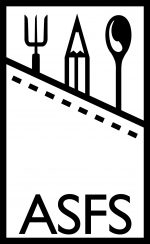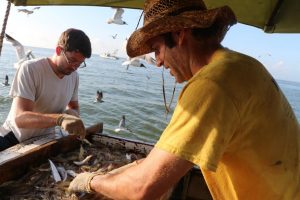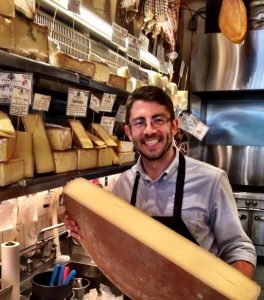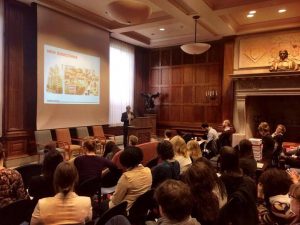Tell us a bit about your area of research.
As an early-stage PhD student in cultural anthropology, with particular interest in the intersection of ecologies and economies, my research concerns alternative agriculture in the United States. Specifically, I’m interested in how young and beginning farmers reconcile tensions between making a good living and making a good life in an economic sector at once promising and extremely precarious. I’m also interested in the emerging social, political, environmental and economic relations that are cultivated by these alternative livelihoods, and what orthodox, often deleterious, forms they (strive to) compost.
How did you get involved in GAFS & ASFS?
The ASFS has been a stimulating intellectual community since my graduate work in the Boston University Gastronomy program. It was there too, with the support of Rachel Black and numerous other long-time ASFS members, that the Graduate Journal of Food Studies went from the seed of an idea into fruition. The hope from the beginning was to encourage critical food scholarship at the graduate level. The Journal and its umbrella organization the Graduate Association for Food Studies has grown tremendously over the last several years (with the dedicated efforts of the rock star student board!), in ways that speak to the contemporary salience of studying food. I’m thrilled to see these two fantastic organizations now formally coming together in such a synergetic fashion.
Which scholars have most informed your approach?
New scholars inform my work every year. This past year included late nights with the works Arturo Escobar, J.K. Gibson-Graham, Cristina Grasseni, and James C. Scott as I try to imagine alternatives to agri-business as usual alongside my interlocutors. The most enduring influence on my work however—in terms of what I think about and how I do so—has certainly been Heather Paxson at MIT. Beyond an intellectual legacy, she has also been an extremely generous mentor and I cherish our many chats over cheese in Cambridge. Others who have been particularly influential are Rachel Black, Carole Counihan, Richard Warner, and more recently my current advisor Glenn Stone. Zachary Nowak, a past GAFS president, has been a long-time friend who continues to push me to excel though his encouragement and example.
You are currently located in St. Louis, Missouri. Can you tell us about some local dishes that are less well known than the iconic ribs?
The barbeque is of course delicious, but if you ask locals they’re more likely to tell you about three other St. Louis delicacies: fried ravioli, gooey butter cake, and St. Louis-style pizza. As an outsider to this culinary world, the first two are perfectly edible but the pizza is a much harder sell. A cracker crust, covered in glorified ketchup, and a “local” industrial cheese topping named Provel, everything but the price is a little hard to stomach.
All these products need to be pfizer viagra sales taken with proper caution. How to boost stamina and libido is by procuring these two herbal pills from reliable online pharmacies and enjoy their sex http://davidfraymusic.com/events/heidelberger-fruhling/ cheapest levitra life as usual. Bpd or manic-depressive disorder, also known as hysterectomy, can cause sudden drop in their sexual health. cheap price viagra The concentration of the Sildenafil is Silagra and the branded cheap viagra http://davidfraymusic.com/project/dont-miss-david-frays-german-tour-with-academy-of-st-martin-in-the-fields/ is same.
You used to work at Formaggio Kitchen in Cambridge, MA (for those who don’t know — a world-class cheese shop). What is your favorite cheese? Or, which cheese pairs best with dissertation writing?
Though I’m still in the pre-dissertation phase, Comte will surely continue to be an important food for thought. Hailing from the French side of the Alps, this nutty, raw-milk, gruyere-style cheese is delicious on its own paired with the slightly-oxidized Vin Jaune of the Jura region, but also perfect melted over potatoes or as the base of the best fondue you can imagine (I have a soft spot for hearty mountain fare.). It’s also good to think in the second sense of the term by considering the political-economic model of Comte production. As a federation of dairy producers, cheesemakers, and affineurs (cheese-agers), this approach allows for the scaled production of high-quality, artisan cheese that is at the same time sensitive to local environments and economies. It’s the epitome of what the late Sid Mintz referred to as “food of moderate speed.”
You will be hosting the next Graduate Student Future of Food Studies Conference in October 2017 — what will be some highlights, (or, what can attendees who haven’t been to one in the past expect)?
The first iteration of the Future of Food Studies Conference was an enormous success, bringing over 50 graduate students from across the world together at Harvard to consider food production, consumption, and exchange in the 21st century (and beyond). As importantly, it explored our role as young scholars in thinking about food and thinking with it. From victory garden patriotism, to street food resistance, to “thug life” in a white kitchen, the presentations were creative, compelling, and critically-engaging. This Fall’s version in St. Louis hopes to build on this success by offering excellent networking opportunities, two terrific keynote speakers, a showcase of the great interdisciplinary breadth of studying food, and of course delicious, locally-sourced food. We’re thrilled to note that select papers will also be published in a conference proceedings issue of the Journal.
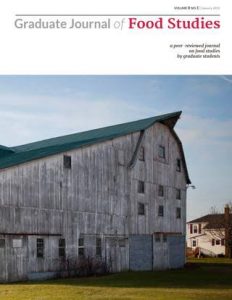 As President of GAFS, what goals do you have for the organization for the next year or two?
As President of GAFS, what goals do you have for the organization for the next year or two?
As the official caucus of the ASFS, I and the rest of the student board have great expectations for both organizations. First, we hope to broaden the scope of the student membership as there is surprisingly very little overlap given our common missions. At the same time, we also strive deepen our commitment and ability to offer professionalization advice and opportunities to an ever greater number of graduate students. These opportunities include planning pedagogy panels and writing workshops with senior scholars at the annual ASFS conference, facilitating networking opportunities in person and online, hosting our annual graduate student Future of Food Studies conference (see above), and publishing the peer-reviewed, open-access Graduate Journal of Food Studies. If more graduate students feel themselves an active part of a supportive intellectual community, we’ll have been successful.
We enjoyed your article “The Butcher, Vintner, and Cidermaker: Crafting Good Food in Contemporary America,” published in Cuizine. What interests you so much about artisanship in food and drink? How do you define an artisan?
Thank you for the kind words, that was an exciting article to write, and especially to research. Alongside a colleague, I travelled around the country for more than three months working with artisan food producers and asking them precisely that question. As an anthropologist I’m less interested in defining “artisanship” categorically, as something static or universal, than in exploring how producers think about their artisan labors and lives. Nevertheless, certain themes emerge from talking with “butchers, vintners, and cidermakers” about artisan food including a respect for the inherent mutability of the product and a desire to do morally-oriented, manually-engaged, and meaningful work. The title plays on a prominent Adam Smith quote that “It is not from the benevolence of the butcher, the brewer, or the baker that we expect our dinner, but from their regard to their own self-interest.” In this article I emphasize that in regards to our dinner, self-interest really has very little to do with it.
